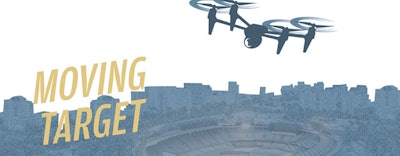

Over the past several years, drones have risen to the top of the threat list for athletic venue operators, leading to venue-specific bans on the devices as well as blanket bans by the FAA at larger sports venues and by the National Park Service outside of designated areas.
At the same time, drones are becoming an asset for athletic teams, venues, even entertainment groups. They can be used to record team practices for later review, fly over construction sites to monitor progress, or dance in a choreographed light display.
Currently, anyone engaging in any of these latter three activities can only do so legally if the device is registered with the FAA, has a special exemption, is operated by a licensed pilot and doesn't violate any local restrictions. Currently.
In late June, the FAA issued its revised rules for Unmanned Aerial Devices (UAS), as the devices are formally known. Here's what anyone, whether a facility owner or recreational enthusiast, needs to know about drone operation before the new rules take effect in August.
CURRENT CLASSIFICATIONS
The FAA defines three categories of UAS: model, civil and public. A model UAS builds off the criteria created for model airplane enthusiasts in the 1980s and establishes a core set of restrictions for all classes: any UAS weighing between .55 and 55 pounds must give way to manned aircraft at all times, is prohibited from flying above 400 feet, cannot fly over people not involved in the device's operation, and must notify local airports if planning to fly within a five-mile radius. In addition, whether model airplane or drone, recreational or hobby aircraft must be operated in accordance with a community-based operations safety guide — that is, the rules established by a hobby group such as the Academy of Model Aeronautics.
The potential for conflict comes in defining recreational use, Scott Lynn, FAA Saftey Team program manager, told a group of NCS4 summit attendees in April. "The hardest thing to describe is what is hobby and recreation. This is where people are going to try to explain their way out. They might be around a football game or flying after school and say they're doing it for fun."
In December 2015, the FAA began to require that all unmanned aerial systems flown for recreational use (including model airplanes) be registered, in part for accountability but also to create an avenue to educate operators on best practices. "Last year, we had two or three million UASes sold," Lynn says. "Put that on top of the ones out there already, and it's three or four million new pilots. None of them have real training. The FAA realized that they needed to get info out safely so that people don't fly where they shouldn't be flying."
When a UAS is being used as part of a person's job or the operator is being compensated for photos or videos taken, its use falls into the civil category, for which new, simplified regulations were unveiled in June. Previously, FAA regulations treat drones operating in this manner as any other commercial aircraft — they had to be operated by a licensed pilot and have an airworthiness certificate, neither of which is a practical requirement for drones. "To be able to use drones legally, we had to carve out an exemption," says Lynn, referring to a process called Section 333. "An FAA administrator can evaluate an applicant who wants to operate a UAS for non-model reasons and issue certain exemptions, provided we deem the device airworthy."
The FAA's new regulation, Part 107, eliminates the need for a 333 exemption in most cases. Previously, UAS exemptions for commercial use were approved on a case-by-case basis; the new regulations outline a process for applying for and receiving permission to fly. The rule also replaces the license requirement with an aeronautics knowledge test, removes the certificate-of-airworthiness requirement, and limits flights to daylight-only operations during which the aircraft must remain in line of site.
The final category of UAS use — public — is limited to government use, applying primarily to military purposes. Common uses may include search and rescue, firefighting or law enforcement. The FAA issues Certificates of Authorization or Waivers of Authorization for this type of use based on aircraft ownership, operator and purpose of flight.

Unwelcome drones: what you can and can't do What can facility operators do when they see an unwanted drone on their property? It depends. It's important to note that simply registering a device with the FAA does not correlate to carte blanche regarding its operation. Operators must also also adhere to state and local laws and ordinances.
First, those suspecting illegal use should find out if the drone is registered. If it is, it's the responsibility of the operator to be aware of the restrictions placed on its use. "If you find one flying around and causing problems, you should be able to look for that registration number," Lynn says. "The number should be marked visibly."
The FAA is not a disciplinary entity but can impose civil fines and jail sentences for operators in violation of its core restrictions. More commonly, enforcement of drone regulations will be handled by local law enforcement. "When you're on the ground, you're in one jurisdiction, take off and it's another," says Lynn. "The FAA can impose civil penalties for being careless and reckless or in violation of a Certificate of Authorization. On the ground side, city ordinances, local law enforcement are the teeth."
The FAA provides guidelines as well as a reference card for local law enforcement officers to follow if they suspect a drone is being flown in an unsafe or unauthorized manner. In addition, local entities can impose penalties based on local ordinances prohibiting drone use (ordinances that may or may not be pre-empted by the new FAA regulations).
To help promote safe use of drones, the FAA also has a "No Drone Zone" outreach program that provides signage to alert operators when they have entered an area that does not allow drones. Such signage has been used at NFL games and college campuses to help raise awareness. The FAA also offers a mobile app that helps users determine if they're in a no-drone area, a hotline for reporting unsafe drone use, and an educational website (knowbeforeyoufly.org).

Special-use considerations The current FAA regulations and classification system still have weak points that are being addressed. Meanwhile, the organization has issued policies specific to certain situations and also continues to grant exemptions for uses that don't fit into any current regulations. Of note:
Large sports venues: Temporary Flight Restriction areas exist over professional sports venues such as NFL stadiums, MLB ballparks and larger collegiate venues. According to the FAA's restrictions, "Unmanned aircraft and remote-controlled aircraft are prohibited within a 3-nautical-mile radius up to and including 3,000 feet above ground level of any stadium having a seating capacity of 30,000 or more people where either a regular or post-season Major League Baseball, National Football League, or NCAA Division I football game is occurring. … Flights conducted for operational purposes of any event, stadium or venue and broadcast coverage for the broadcast rights holder are authorized with an approved airspace waiver."
Students and educational use: In May, the FAA released a memorandum on the educational use of drones, placing use by students under the recreational/hobby classification. Previously, such operations required a 333 exemption. "We find that the use of small unmanned aircraft by students at accredited educational institutions as a component of science, technology and aviation-related educational curricula or other coursework such as television and film production or the arts more closely reflects and embodies the purposes of 'hobby or recreational' use," the memo reads, noting, however, that the definition does not apply to faculty. Drones cannot be used by faculty or students for research purposes, and faculty involvement in a student's drone use must be minimal.
Applying for exemptions: While the implementation of Part 107 will allow many civil operators to fly aircraft without an exemption, it won't cover everything, and the FAA will continue to approve exemptions on a case-by-case basis. For instance, Intel was recently granted permission to fly 100 drones operated by one pilot with a computer (bypassing the requirement of one pilot per drone) as part of a choreographed lightshow in Palm Springs, Fla., which the company hopes to eventually conduct over stadiums or large crowds. Similarly, drone racing enthusiasts would need to apply for an exemption that would allow them to operate at speeds in excess of 100 miles per hour or out of the operator's line of sight.
On the horizon There are plenty of people and organizations unhappy with the current progress of the FAA's drone policies. Companies like Amazon (whose drone-delivery plan has been grounded by the latest proposed rules) and tech powerhouse Google, in particular, are eager to see greater flexibility. In May, speaking at the Association for Unmanned Vehicle Systems International Conference in New Orleans, FAA administrator Michael Huerta announced, among other things, the establishment of a drone committee to focus on integration, tapping Intel CEO Brian Krzanich to lead the committee.
"The innovation in this field is speeding forward at a breakneck pace," Huerta said. "When you compare it to [manned] aviation, consider this: the development schedule for a new type of commercial airliner is every 15 to 20 years. The drone development schedule, by contrast, is so compressed that new products are flying out of the design studio and into factories at the blink of an eye."
Huerta outlined three priorities for the committee: safely enabling UAS operations, adaptability to keep pace with emerging technology, and creation of global standards.
The FAA is also considering the creation of a set of regulations specifically for micro UAS — those weighing less than .55 pounds. Such devices would have different allowances for flying over crowds, dependent on weight, as well as impact-energy threshold. The current recommendation establishes four categories based on level of risk to people. "The FAA and industry have come to understand that we both come from a safety-first perspective," Huerta said. "And we recognize that we have to find the right balance to support safe integration without stifling innovation."
This article appeared in the July/August 2016 issue of Athletic Business. Athletic Business is a free magazine for professionals in the athletic, fitness and recreation industry. Click here to subscribe.

































